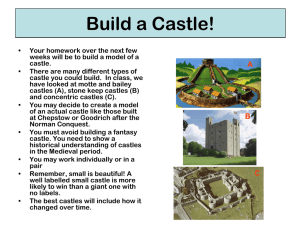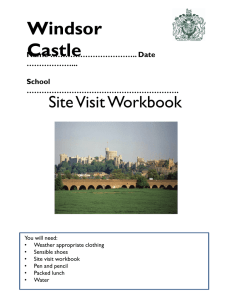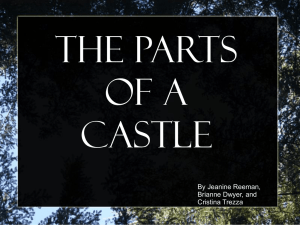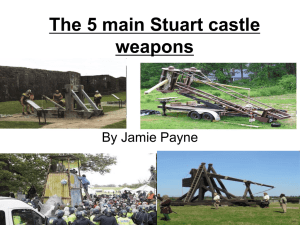Site Workbook answers (1)
advertisement
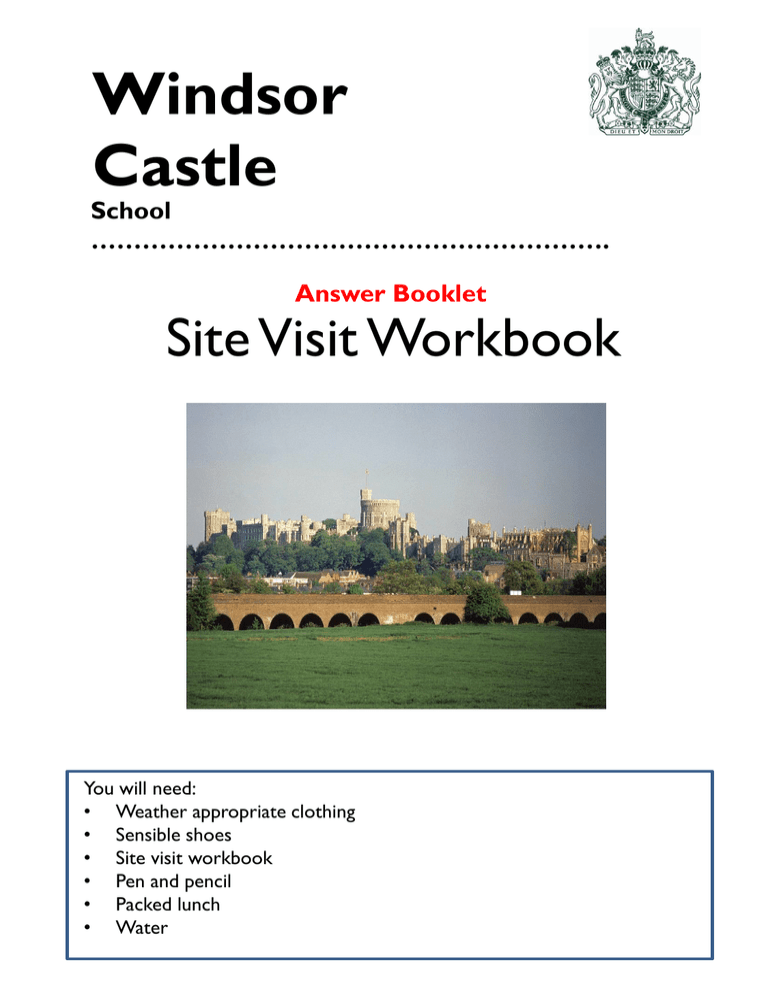
Windsor Castle School ……………………………………………………. Answer Booklet Site Visit Workbook You will need: • Weather appropriate clothing • Sensible shoes • Site visit workbook • Pen and pencil • Packed lunch • Water Security at Windsor Castle Windsor Castle is a working royal palace • On arrival, you and your belongings will be subject to airport-style security checks. Please try to bring as little as possible with you as it will help you to get through security screening more quickly. • Eating and drinking are not permitted in the State Apartments or St George’s Chapel. You will be asked to place drinks and food in closed bags before being admitted to the Castle. • Photography and filming are not permitted inside the State Apartments, the Semi-State Rooms or St George's Chapel. • Large backpacks are not permitted in the State Apartments and must be checked in. What do you know about Windsor Castle and its use today? Windsor Castle is: • oldest and largest inhabited castle in the world. • one of the Queen’s Official Residences, which include Buckingham Palace, in London and The Palace of Holyroodhouse, in Edinburgh. • home to over 40 British Kings and Queens in its 900 year history • never been allowed to fall into disrepair or become a ruin. Windsor Castle was built in about 1080, for William the Conqueror. Why did William build castles to live in? William was a French Nobleman, Duke of Normandy, promised the crown of England by the King at the time Edward I, but when the King died he named his successor as Harold. When William became king after the Battle of Hastings, he needed lots of safe places to live, so built castles. William chose Windsor as a site for his Castle for 3 main reasons. For each reason given below, explain why this was important: • On a hill: • It is an easily defended site, high up on a hill, and it has a sheer cliff on the one side, the North terrace. • You can easily see the enemy approaching • Next to a River: • On one side of the site is the River Thames which would provide a natural barrier which is difficult for an enemy to cross. • A river is useful to transport people and goods to and from London • Near a Forest: • The forest provided the materials needed to build the castle and was easily accessible. • The animals living in the forest could be hunted to provide food. William’s Castle was built as an earth and timber fortress, and was part of a ring of castles around London, each 20 miles from each other. Why did William build a Castle of wood? • Wood was quicker to build than other materials although the wooden castle still took 10 years to build. • Wood was an easily available resource from the forest nearby. • Wood is strong. Why do you think the castles were placed 20 miles apart? William marched across the land but met some rebellion. On reaching London, he then built his main castle, the Tower of London. Then he had a ring of castles around London built, each 20 miles from the Tower of London, and 20 miles from each other (on about the line of the M25 today). 20 miles was a days the march Windsor defended westforofthe soldiers then! London, and the other 8 castles defended the other directions. In the event of an attack at any of the castles a beacon would be lit at the site and this would alert the neighbouring castles. They could then send reinforcements to the castle being attacked. Hertford Berkhamsted Tower of London Rayleigh Ongar Rochester Windsor Tonbridge Guildford Reigate Motte and Bailey. Bailey Motte The Motte is the mound in the middle, with the Keep on the top. The Bailey is the area to the side of the Motte. Discuss why you think there are 2 Baileys at Windsor. Mainly because the site is long and covers a large area. This picture shows the Castle rebuilt in stone in the 1170s. Why is stone better than a wooden fortress? Henry II replaced the wooden castle walls with stone walls, (In fact it took 60 years to replace all the wooden walls with stone), to the same motte and bailey design. • the boundaries of the Castle Walls have remained the same for over 900 years. • There is ½ a mile of stone boundary walls here, and those walls are in places 4 metres thick, comprising of stone wall either side and an infill of stone. • The stone keep, later known as the round tower, was built to replace the Can you guess why the moattower. at Windsor Castle had no water in it? (Clue: the original square wooden answer is to do with geography and soil structure). The soil at Windsor is chalky and porous, so the water would soak away, but a dry moat is just as useful to stop the enemy from getting to the walls. • Windsor Castle has thick stone walls, in some placed up to 4 metres thick. Look at these pictures of the towers situated along the outside wall. Why do you think they are wider at their base? Some of the Towers appear to be wider at their bases to the tower walls and provide a slope from which missiles or dropped from the walls above would bounce off towards the The tower in the first picture (above) is the original shape, however some of these towers where later given a curved outer edge. Why do you think that happened? Round towers gave an all round better view, and missiles aimed at them would glance off. If you asked a small child to draw a picture of a castle, it is likely they would use this shape at the top of the walls. Can you think of any words we associate with this part of the Castle? Battlements Crenellations Ramparts Crenel and Merlon Find some Arrow Slits (or Arrow Loops). • Why is the opening so narrow? So the enemy can’t see the defenders, or fire their arrows through the small gap. • Why is it the shape of a cross? The horizontal part of the opening allows a better view of the enemy. When a crossbow was used, the front of it could be rested on the cross part of the frame, to take the weight and assist with achieving a better aim. • Why the need for a recess (hollowed-out space) in the inside wall? The defending bowman can move around within the space to get a better view of and aim at the attackers. • Why was the enemy attacking the Castle at such a disadvantage? The enemy would be trying to advance close enough to get a good shot whilst under fire from the defenders. The chances of success were pretty slim. Look closely at the stone walls. Why do you think flint was placed between the stone blocks (galetting)? • To provide support for the large and heavy stones during construction of the walls, so that the mortar could dry in the correct position. • To make it difficult for the enemy to climb the walls – their hands would be cut on the sharp flint. Stone Gateways and keeping the enemy out. • You will see lots of stone gateways around the Castle. Name some defensive features you can find in and around them. Tall stone towers, battlements, small windows, narrow doorways, strong heavy wooden doors. • Look up when you are passing through a gateway. What can you see? The gap where the portcullis would be and murder holes. • What kind of defensive doorway would you once have seen at Henry VIII gate? A drawbridge. Siege – the Castle under attack. On two occasions during its 900 year history, Windsor Castle has been attacked. In 1216 local Barons attacked many castles, including Windsor. Why do you think this happened? During 1216 Windsor was under siege, this was 1 year after King John signed the Magna Carta at Runnymede in June 1215. The Magna Carta was the first Human Rights Charter, importantly it gave the ordinary people of the land the right to have a fair trial. It also gave rights to the Church, Barons, and the people. The King was bound by this law of the land too, however King John was not happy with this and changed his mind. So, in anger at the King’s decision, the rebel Barons rose up against him. The Castle was held by King John, and 60 Knights that were loyal to him. The siege lasted 3 months and of all the Castles that were attacked at that time, only Dover and Windsor were held for the King. (King John died late in 1216) Draw an arrow to link the label with the picture of the siege weapon below: Pontoon Bridge Ballista Siege tower Scaling ladder Catapult or Mangonel Battering ram An attacking army had other methods at its disposal. Have a look at these and comment on what they are or how they might be achieved. Deception Spies were used to infiltrate the castle. They could open the castle gates at night or wreak havoc on the interior defences of the castle. The most famous case of this tactic is the Trojan Horse. Treachery: Someone trusted within the power structure of the castle could give misleading information that would bring down the castle. He could for example report that there were many more troops sieging the castle than there actually were. This would induce the castle residents to either revolt or surrender out of fear. Starvation: This was a method used but it often meant many months, sometimes even a year or more. The sieging army would station itself around the castle and not allow any form of commerce. Eventually the inhabitants would surrender due to imminent starvation. Biological warfare: Yep that's right. A sieging force could launch the remains of rotting corpses into the castle causing outbreaks of life-threatening illness. Mining: The sieging army would actually dig tunnels under the castle. The hope was not so much for an entry into the castle but for a way to collapse the castle defences. Simple storm: The sieging force could carry out a co-ordinated attack at various points of the castle. This overwhelming act would hopefully break through in some places causing a collapse in defences. Further developments in warfare. Gunpowder was introduced in 1346 (its use was recorded at the Battle of Crecy), 100 years before the Wars of the Roses. • What evidence can you find that cannons were ever needed for use at Windsor Castle? • Consider how the introduction of gunpowder and cannons may have changed the way a battle was fought, and therefore how a Castle was defended. The use of cannons as a destructive weapon brought about a change in the success of siege warfare. The powerful new weapon essentially rendered the traditional walled fortification of Europe, which had been impregnable for centuries, weak and defenceless. We can see some of the cannons around our site at Windsor Castle, although they may not have been used often as this period of history saw battles being fought overseas and not so close to home. The next important step for gunpowder came when it was inserted into the barrel of a handgun, which first appeared in the mid-15th century and was essentially a cannon shrunk down to portable size. Guns literally put weaponry into the hands of the individual, creating a new class of soldier — infantry — and giving birth to the modern army. St. George’s Chapel. What can you find out about the flags in the Chapel and the group of people they represent? In 1348 Edward III formed the Order of the Knights of the Garter, the oldest and most important order of Chivalry. It consisted of the Sovereign, the Prince of Wales, and 24 Knights. In St Georges Chapel, you will see the flags of the Knights of the Garter today. Poised on the roof are some figures. What do you think they are for? Adorning the roof of St. George’s Chapel are seventy-six stone animals known as the Windsor Royal Beasts. They hold wind vanes and coats of arms, and depict fourteen different heraldic animals associated with the Plantagenet & Tudor Royal families: The Crowned Golden Lion of England The Red Dragon of Wales The Silver Falcon of York The Black Bull of Clare(nce) The Heraldic Panther of Queen Jane Seymour The Beaufort Yale of Kendal The Mortimer White Lion of March The White Greyhound of Richmond The Bohun White Swan of Hereford The White Hart of Richard II The Bohun Collared Silver Antelope The Black Dragon of Ulster The White Unicorn of Edward III The Golden Hind of Kent Why do you think there is a church within the Castle walls? Usually a castle had a chapel that could be located in a tower or gatehouse. The chapel sometimes served as a private church for the lord and his family even when there was another church in a nearby town. Use these pages to make some sketches and notes of things or features of the Castle to remind you for follow up at school. Created by Royal Collection Trust, Learning with thanks for contributions from Baylis Court School. Find out more at www.royalcollection.org.uk/learning Learn more about St George’s Chapel at www.stgeorgeswindsor.org October 2014


